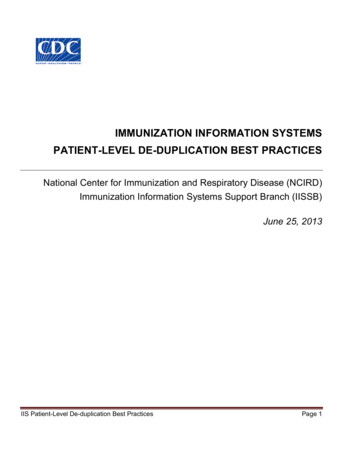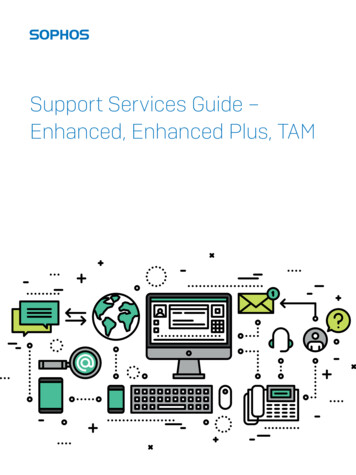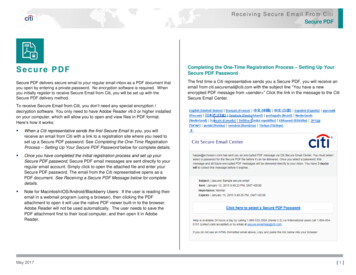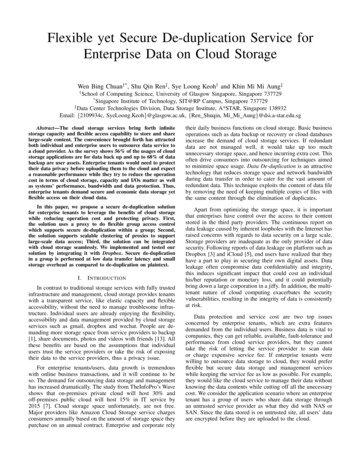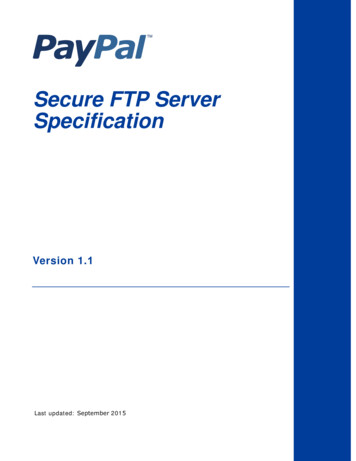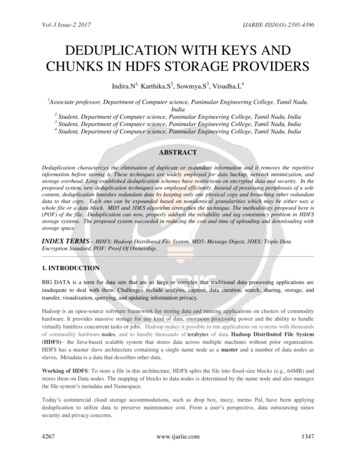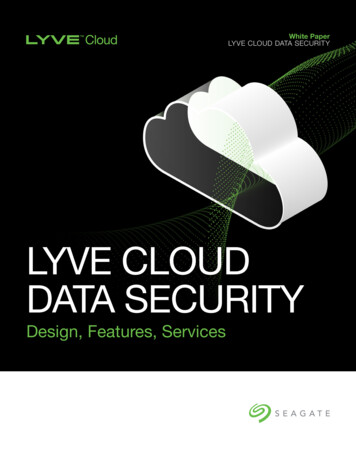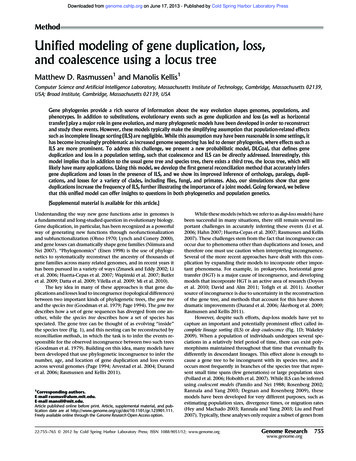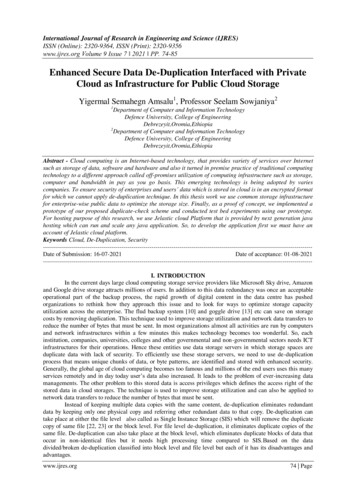
Transcription
International Journal of Research in Engineering and Science (IJRES)ISSN (Online): 2320-9364, ISSN (Print): 2320-9356www.ijres.org Volume 9 Issue 7 ǁ 2021 ǁ PP. 74-85Enhanced Secure Data De-Duplication Interfaced with PrivateCloud as Infrastructure for Public Cloud StorageYigermal Semahegn Amsalu1, Professor Seelam Sowjaniya21Department of Computer and Information TechnologyDefence University, College of EngineeringDebrezeyit,Oromia,Ethiopia2Department of Computer and Information TechnologyDefence University, College of EngineeringDebrezeyit,Oromia,EthiopiaAbstract - Cloud computing is an Internet-based technology, that provides variety of services over Internetsuch as storage of data, software and hardware and also it turned in premise practice of traditional computingtechnology to a different approach called off-promises utilization of computing infrastructure such as storage,computer and bandwidth in pay as you go basis. This emerging technology is being adopted by variescompanies. To ensure security of enterprises and users’ data which is stored in cloud is in an encrypted formatfor which we cannot apply de-duplication technique. In this thesis work we use common storage infrastructurefor enterprise-wise public data to optimize the storage size. Finally, as a proof of concept, we implemented aprototype of our proposed duplicate-check scheme and conducted test bed experiments using our prototype.For hosting purpose of this research, we use Jelastic cloud Platform that is provided by next generation javahosting which can run and scale any java application. So, to develop the application first we must have anaccount of Jelastic cloud platform.Keywords Cloud, De-Duplication, -----------------------------------------Date of Submission: 16-07-2021Date of acceptance: -------------------------------------------I. INTRODUCTIONIn the current days large cloud computing storage service providers like Microsoft Sky drive, Amazonand Google drive storage attracts millions of users. In addition to this data redundancy was once an acceptableoperational part of the backup process, the rapid growth of digital content in the data centre has pushedorganizations to rethink how they approach this issue and to look for ways to optimize storage capacityutilization across the enterprise. The flud backup system [10] and goggle drive [13] etc can save on storagecosts by removing duplication. This technique used to improve storage utilization and network data transfers toreduce the number of bytes that must be sent. In most organizations almost all activities are run by computersand network infrastructures within a few minutes this makes technology becomes too wonderful. So, eachinstitution, companies, universities, colleges and other governmental and non-governmental sectors needs ICTinfrastructures for their operations. Hence these entities use data storage servers in which storage spaces areduplicate data with lack of security. To efficiently use these storage servers, we need to use de-duplicationprocess that means unique chunks of data, or byte patterns, are identified and stored with enhanced security.Generally, the global age of cloud computing becomes too famous and millions of the end users uses this manyservices remotely and in day today user’s data also increased. It leads to the problem of ever-increasing datamanagements. The other problem to this stored data is access privileges which defines the access right of thestored data in cloud storages. The technique is used to improve storage utilization and can also be applied tonetwork data transfers to reduce the number of bytes that must be sent.Instead of keeping multiple data copies with the same content, de-duplication eliminates redundantdata by keeping only one physical copy and referring other redundant data to that copy. De-duplication cantake place at either the file level also called as Single Instance Storage (SIS) which will remove the duplicatecopy of same file [22, 23] or the block level. For file level de-duplication, it eliminates duplicate copies of thesame file. De-duplication can also take place at the block level, which eliminates duplicate blocks of data thatoccur in non-identical files but it needs high processing time compared to SIS.Based on the datadivided/broken de-duplication classified into block level and file level but each of it has its disadvantages andadvantages.www.ijres.org74 Page
Enhanced Secure Data De-Duplication Interfaced with Private Cloud as Infrastructure .Disadvantages of block level de-duplication Block de-duplication requires more processing power than the file level de-duplication The number of identifiers that need to be processed increases greatly. Its index for tracking the individual chunks of each block gets also much largerAdvantages of file level de-duplication It requires less processing power since files’ hash numbers are relatively easy to generate. So, the file-level de-duplication can be performed most easily It does not require many CPU and memory resources to implement. Tags (indexes) of the file are smaller. This is for short duplicate searching computation in whichduplication check is conducted. The while reassembly check is conducted in block level de-duplication because when we come to filelevel de-duplication reassembly is very less since only unique files are stored.II. MOTIVATION OF THE STUDYThe cloud computing paradigm is the next generation architecture for the business of informationtechnology which presents to its users some huge benefits in terms of computational costs, storage costs, andbandwidth and transmission. Costs typically the cloud technology transfers all the data, databases andsoftware’s over the internet for the purpose of achieving huge cost savings for the CSP. Due to this explosivegrowth of digital data, there is a clear demand from CSP for more cost-effective use of their storage andnetwork bandwidth for the data transfer purpose. Also, the use of Internet and other digital services have givenrise to a digital data explosion, including those in cloud storagesIII. RELATED WORKSIn this sub chapter we refer different research papers from IEEE and ACM publications and we werediscussed or tried to review different literature that are written by other researcher and have an idea relatedwith this study as we analysis these papers we are coming to our work by using gaps of the literature as abuilding block while literatures are used for our initial idea.[15] Address Data de-duplication is a technique for eliminating duplicate copies of data, and has beenwidely used in cloud storage to reduce storage space and upload bandwidth. Promising as it is, an arisingchallenge is to perform secure de-duplication in cloud storage. Although convergent encryption technique hasbeen extensively adopted for secure de-duplication, a critical issue of making convergent encryption practical istoo efficiently and reliably manages a huge number of convergent keys. They first introduce a baselineapproach in which each user holds an independent master key for encrypting the convergent keys andoutsourcing them to the cloud. However, such a baseline key management scheme generates an enormousnumber of keys with the increasing number of users and requires users to dedicatedly protect the master keys.[3] The authors propose de-duplication for VM which is different from the other de-duplicationmodels’ researchers considers in virtualization environment actually it is useful for efficient use of storagespace but their system protects de-duplication replacing from the old data not from the new entry.[20] The authors use the technique of map reduce special feature of map reduce function toautomatically partition the computing job according to the security level of the data. So, the computation ofdata is on private cloud the computation of non-sensitive data is done on the public cloud. The authors usehybrid cloud architecture they only consider data security they don’t consider data duplication in the publiccloud.[35] Cloud storage systems are becoming increasingly popular. A promising technology that keepstheir cost down is de-duplication, which stores only a single copy of repeating data. The outers used thetechnique of client-side De-duplication attempts to identify de-duplication opportunities already at the clientand save the Bandwidth of uploading copies of existing files to the server. In this work we identify thedrawback is that exploit client-side de-duplication, allowing an attacker to gain access to arbitrary-size files ofother users based on very small hash signatures of these files. More specifically, an attacker who knows thehash signature of a file can convince the storage server that it owns that file.[23] Cloud storage service providers such as Drop box, Mozy, and others perform de-duplication tosave space by only storing one copy of each file uploaded. The authors for DupLESS Server-Aided Encryptionfor De-duplicated Storage attempts to solve space saving and security and they address cross user deduplication clients encrypt under message-based keys obtained from a key-server via an oblivious PRFprotocol. The drawback of this work doesn’t consider clients privilege and it only supports simple storagewww.ijres.org75 Page
Enhanced Secure Data De-Duplication Interfaced with Private Cloud as Infrastructure .interface. At the same time the author doesn’t consider channel privacy leakage in cross user de-duplicationwhich reveals information of the file.[33] The authors of ClouDedup: Secure De-duplication with Encrypted Data for Cloud Storage thispaper uses the technique of convergent encryption to achieve confidentiality while de-duplication feasible inblock level de-duplication here we identify two draw backs effects one is efficient key management for theever-increasing file and processing time for each block of data while it searches duplicate file takes long time[27] The authors’ of this paper suggests de-duplication as a potential application of their incrementaldeterministic public-key encryption scheme. But this will only work with a single client. It won't allow deduplication across clients, since they would all have to share the secret key.[43] This paper uses fault Tolerant digital signature Scheme to improve the speed of data deduplication and data integrity for the outsourced data. The data de-duplication strategy used in proposedscheme is the fixed-sized blocks and block-level de-duplication the main drawback of this paper is the worstcase in that cloud storage server will regard all blocks as a new blocks and store all of these blocks, resultingin storing duplicate blocks.[28] The authors of this paper mainly focus on to optimize the private cloud storage backup in order toprovide high throughput to the users of the organization by increasing the de-duplication efficiency. The mainlimitation of the paper is the concern is given for de-duplication not for the security as well.III. METHODOLOGYSecure Hash Algorithm (SHA) was developed by NIST along with NSA [31] in 1993; SHA waspublished as a FIPS. The SHA is called secure because it is designed to be computationally infeasible to findtwo different messages which produce the same message digest. Any change to a message in transit will resultin a different message digest, and the signature will fail to verify. Secure Hash Algorithm (SHA) is necessaryto ensure the security of the Digital Signature Algorithm (DSA).It takes a message of any length 2 64 bits asinput and produces a 160-bit message digest as output. The message digest is then input to the DSA, whichcomputes the signature for the message. Signing the message digest rather than the message often improvesthe efficiency of the process, because the message digest is usually much smaller than the message.Advanced Encryption StandardThe more popular and widely adopted symmetric encryption algorithm likely to be encounterednowadays is the Advanced Encryption Standard (AES). The Advanced Encryption Standard (AES) is aspecification for the encryption of electronic data established by the U.S. National Institute of Standards andTechnology [29].AES is based on the Rijndael cipher developed by two Belgian cryptographers, JoanDaemenand Vincent Rijmen, who submitted a proposal to NIST during the AES selection process. Rijndael isa family of ciphers with different key and block sizesHashed Message Authentication CodeHMAC treats the hash function as a black box. This hash two benefits. First, an existingimplementation of a hash function can be used as a module in implementing HMAC. The bulk of the HMACcode is pre-packaged and ready to use without modification. Second, to replace a given hash function in anHMAC implementation, we must simply remove the existing hash function module and drop in the newmodule. This could be done if a faster hash function were desired. More important, if the security of theembedded hash function were compromised, the security of HMAC could be retained simply by replacing theembedded hash function with a more secure one (replacing with SHA-1)Proof of Ownership ProtocolProof of ownership is the protocol in which it enables to protect uploading the same content of data inthe storage while it proves the ownership to the storage server to avoid duplicate copies. Here this is run inbetween the user and the storage server (prove, verify). When we say prove the user should have to pass his/heridentity to the server. A short value of token(M) is derived by the verifier from the data copy M to prove theowner ship of the M. Hence the token is the tag of the M and privileges of the user. Generally POW is theprotocol where the client proves the server that it has the original file M. Proofs of ownership (PoW) for deduplication systems, such that a client can efficiently prove to the storage server that he/she owns a file withoutuploading the file itself [26] Proposed an alternate PoW plan by selecting the projection of a record onto somerandomly chosen bit-positions as the record verificationwww.ijres.org76 Page
Enhanced Secure Data De-Duplication Interfaced with Private Cloud as Infrastructure .Figure 3-5 Proof of Ownership ProtocolIn the above figure both Yigermal and Semahegn have the File F. if they want to upload to the storageserver two of them need not to upload. Semahegn only shares the privileges of yigermal rather than to uploadthe same content of the file. This means that while yigermal is the owner of the file semahegn linked to the fileor takes pointer of the file F.Token GenerationFigure 3-6 Token GenerationsIV. SELECTION OF CLOUD PLATFORM AND SERVICE PROVIDERThis chapter discussed all about the platforms and the service providers that are selected in this studyand in this case this we look over more 6 service provider and from this the research is most discussed aboutjelastic public cloud platform because in this research we use this platform as PaaS environmentAnalysis and Comparison of Cloud Application Development and Hosting PlatformsIn this research we select platform as a service provider by comparing the different service such assoftware as a service, dedicated IT, hosting provider and infrastructure as a service by the following figure wecan consider the difference and we can compare them and we can select one of the best services that is suitablefor this research.www.ijres.org77 Page
Enhanced Secure Data De-Duplication Interfaced with Private Cloud as Infrastructure .Figure 1-1 Comparison among cloud servicesJelastic Public Cloud PlatformJelastic is a cloud services provider that combines PaaS (Platform as a Service) and CaaS (Containeras a Service) in a single package for hosting providers, telecommunication companies, enterprises anddevelopers. Jelastic provides support of Java, PHP, Ruby, Node.js, Python, .NET, Go environments andcustom docker containers.The deployment can be easily performed using GIT/SVN with automatic updates,archives (zip, war, ear) right from the dev panel or via integrated plugins like Maven, Eclipse, NetBeans,IntelliJ IDEA.V. THE PROPOSED DEDUPLICATION ARCHITECTUREThis chapter describes the architecture of the proposed de-duplication system.At a high level, our setting of interest is an enterprise network, consisting of a group of a listedclients (for example, employees of a company) who will use the S-CSP and store data with de-duplicationtechnique. In this setting, de-duplication can be frequently used in these settings for data backup and disasterrecovery applications while greatly reducing storage space. In our thesis we have to follow the hybrid clouddata model for our prototype development and system architecture.Now a day’s cloud service providers offer both highly available storage and massively parallelcomputing resources at relatively low costs. These service providers provide services by hiding implementationand platform at the same time so by using virtualization it is possible to provide unlimited services. To solvestorage problem as well as privacy we try to solve using de-duplication with enhanced data security. Althoughdata de-duplication brings a lot of benefits, security and privacy concerns arise as users’ sensitive data aresusceptible to both inside and outside attacks. For saving resources consumption in network bandwidth andstorage capacities, many cloud services, namely Drop box apply client-side de-duplication. Our assumption isby taking large enterprises which uses common storage service. Example college systems which consist ofmany Departments like Administration, Examination Control, information Technology, Electronics etc andstudents too. All the repeated data of these departments are stored in cloud thus occupying a huge storagespace.File Uploading Algorithm1. User should register first2. User should Login to enter into the system.www.ijres.org78 Page
Enhanced Secure Data De-Duplication Interfaced with Private Cloud as Infrastructure .3. User selects a file F4. Compute tag of F( F TagGen(F )) request token of F to private server and private server module resentto user token of F({( ’F TagGen( F, kp ))WhereF File token,kp privilege key5. User requests token of Fto public cloud for de-duplication and public cloud verify token weather it exist ornot and sent the result to the user finally public cloud module verifies.6. If user gets not duplicate it proceeds to upload else server runs POW.7. While uploading the user performs :a) User gets key from private cloud KF ,KF key of the fileb) CF Encrypt(F, kF )c) While receiving CF , the private cloud server module generates token of the file ( F) and privilegekeys of the file owner (PK) for final uploading to the public cloud. Hence,Fis uploaded to the public whilekF and PK is stored in the database.8. End.VI. IMPLEMENTATIONCloud User ModelA user is an entity that wants to outsource data to the S-CSP and access the data later.Therefore a userfirst registers to the system and gets his/her username and password. After a user is authenticated by the systemuser logged into the user page and selects a file to generate hash value of the file. This hash value of the file isused for computation of the file token.Figure 6-4 Hash Computation Value of the fileAs we have seen from fig 6-3 a file is first computed using secure hash algorithm. This file tag is send to theprivate cloud module. In private cloud module there is hash based message authentication code (HMAC) tocompute the file token ( F).Private Cloud ModelIt is honest and credible server which computes secure operations of privilege keys and file tokens arecomputed by the private cloud module. For computation of file token user computes hash of the file and sendsto the private cloud. This file token is used to prevent duplication in public cloud storage.Figure 6-5 Token of the fileThe user clicks DCHEEK link. If the file is not yet stored in the public cloud the file is uploaded to cloud but ifthe file is already stored in the cloud the server runs proof of ownership to the stored file.www.ijres.org79 Page
Enhanced Secure Data De-Duplication Interfaced with Private Cloud as Infrastructure .Figure 6-6Proof of OwnershipThe second user shares the privilege keys of the first user to have the ownership of the file. Hence ifthere are any subsequent users of this file the content of the file is not yet uploaded. The subsequent user’sshares reference of the file attribute from the first user.Figure 6-7 File attributes shared by Subsequent usersIn the above figure 6-5 the first user file id is 2 and the owner of the file is OSU12 which is shared bythe subsequent user. The subsequent user file id is 211 and file name is de.pdf. Finally these subsequent useruploads file attributes rather than the file content.Public Cloud ModelIn this module, we develop Cloud Service Provider module as storage of encrypted metadata files in apublic cloud module. This is an entity that provides data storage service in public cloud. The S-CSP providesthe data stores encrypted data on behalf of the users. To reduce the storage cost, the S-CSP eliminatesredundant data via De-duplication and keeps only unique data.The following fig shows the proto type of thepublic cloud model in which it stores only unique files.Figure 6-8 Public Cloud ModelVII. RESULTS AND DISCCUSIONSThe data used for this experiment was collected from the data center of the Oromia State University.The university comprises of the following departments each department have their own data in the data centerwhich uses samba file server: Information Technology Law Accounting and Public Finance Economics Business and Information System Human Resource and Leadershipwww.ijres.org80 Page
Enhanced Secure Data De-Duplication Interfaced with Private Cloud as Infrastructure . ManagementEnglishCommunication MediumThe server and client machine are connected via category 6 UTP cable. The reported data rate of the local areanetwork is 90 Mbps.Experiment ParametersFrom here we see the following parameters:1. The download parameter2. The upload parameter3. Time parameter4. Network usage and server loadThe download parameter was deliberately ignored as it cannot be optimized. Any user who later wants get hisfile must download it from the server at a rate of the network speed. There is no other way out. Uploadinghowever can be optimizedThe department of IT with respect to the remaining department was analyzed and the following results werefound.The total size of these files is 16 GB out of which only 12.5GBis unique to the department. The remaining 3.5GB was duplicate to the departments. As a result3.5 GB of disk space was wasted.Figure 7-2 file duplication in IT DepartmentAs it can be seen from figure 7-2 12.5 GB of which is 21.88 % (3.5*100/16) of the optimum size has beenwasted. Similarly, analysing files of all departments at the same time has produced the following results.Figure 7-3 File duplication across all departmentswww.ijres.org81 Page
Enhanced Secure Data De-Duplication Interfaced with Private Cloud as Infrastructure .Overall, 33.3% of duplication was found across all departments. And the results show that applyingde-duplication could have saved 8 GB of diskFile Size(KB)Elapsed Time in MillisecondsRatiospace. No more explanation is required hereFirstUpload/NextFirst UploadNext Uploadto convince the advantages of de-duplicationUploadwith regard to storage efficiency. If we look65.511.55.7at the case large scale servers for example 2MB3.5MB136.813.010.5cloud storage servers, the size of disk space8MB220.013.016.9consumed and the logistics required to run10MB258.92211.8the service is enormous. Imagine the benefitsof applying de-duplication in a world where 75% of its digital data are duplicate copies [16]. The nextadvantage of file de-duplication is reducing the network traffic, reduced transmission time and reducing theserver load.7.3.1 Network usage and Server load ParameterAs it can be seen from the table above, elapsed time of the first upload increases as the file increases.The time needed to complete next uploads shows very little variation as the size of the file increases.The difference in elapsed time between the first upload and subsequent uploads can be clearly shownin the following graph.As it can be seen from Table 7-2, it is easy to conclude that network traffic can be minimized if deduplication is applied. For example, let us see the case of 10 Mb file, it has taken 258.9 milliseconds tocomplete the upload. However since the next upload request needs only to provide proof, it has taken only 11.8milliseconds. Hence it can be concluded that applying de-duplication improves storage efficiency,minimizes server load and increases network band width.Figure 7-4 Elapsed time of first upload vs subsequent uploadsVIII. CONCLUSION, RECOMMENDATION AND FUTURE WORKIn this paper we studied that security and efficient use of storage space. De-duplication technique isvery important for cloud storage service providers to manage the ever increasing user’s data and data storageservers. Duplication of the files is identified by file tokens. This is secure for external and internal attacks.Hence authorized user uses file tokens for duplication check with files stored in public cloud module. We useprivate cloud module for secure data operation while the public cloud module uses as S-CSP to store encrypteddata storage and used for to protect redundant file which have different file name but have the same contents.Generally as the demand of data stored increases in the cloud data de-duplication is one of the techniques usedto improve storage efficiency.RecommendationsNow a day’s most organizations, institutions, colleges and universities have their own data at datacenters. Example in real scenario we had tried to observe the Oromia State Universities data center. Theuniversity has department data in the file server (samba file server). Each instructor uploads many repeatedwww.ijres.org82 Page
Enhanced Secure Data De-Duplication Interfaced with Private Cloud as Infrastructure .data in this file server. If we apply this work in real scenario we will have different advantages for ICTadministrators, for users and for the university.For ICT administrators they will get good knowledge in security and efficient use of data servers. Forusers it lets secure de-duplication operation and technology transfer and it creates creation awareness inresource management. For the university it saves extra coast encourage having additional file servers andincreases the confidence in security. Finally small change in file content would result in a completely differenthash value. Hence, identifying duplicates using a hash function is not applicable. Further research is requiredthat addresses this issue.Future worksThe proposed system can be extended further, as a future work for successful implementation and deploymentof this work in real time scenario like large industries data center & institutions with additional proto typefunctionalitiesA. Preparing Your Paper1) Paper Size: Prepare your paper in full-size format on US letter size paper (8.5 by 11 inches).2) Type Sizes and Typefaces: Follow the font type sizes specified in Table I. The font type sizes are given inpoints, same as in the MS Word font size points. Times New Roman is the preferred font.3) Paper Margins: Paper margins on the US letter size paper are set as follows: top 0.75 inches, bottom 1inch, side 0.625 inches. Each column measures 3.5 inches wide, with a 0.25-inch gap between the twocolumns.4) Paper Styles: Left- and right-justify the columns. On the last page of your paper, adjust the lengths of thecolumns so that they are equal. Use automatic hyphenation and check spelling and grammar. Use highresolution (300dpi or above) figures, plots, drawings and photos for best printing result.TABLE ITYPE SIZE FOR PAPERSType size (pts.)68AppearanceRegularTable superscriptsSection titlesa, references, tables, tablenamesa, table captions, figure captions,footnotes, text subscripts, and superscripts1122ItalicAbstract, IndexTerms910BoldAuthors' affiliations, main text, equations,first letter in section titlesaAuthors' namesPaper titleSubheadingaUppercaseB. Preparing Your PDF Paper for IEEE Xplore Detailed instructions on how to prepare PDF files of your papers for IEEE Xplore can be found athttp://www.ieee.org/pubs/confpubcenterPDF job setting files for Acrobat versions 4, 5 and 6 can be found for downloading from the above webpage aswell. The instructions for preparing PDF papers for IEEE Xplore must be strictly followed.II. HELPFUL HINTSA. Figures and TablesTry to position figures and tables at the tops and bottoms of columns and avoid placing them in themiddle of columns. Large figures and tables may span across both columns. Figure captions should be centeredbelow the figures; table captions should be centered above. Avoid placing figures and tables before their firstmention in the text. Use the abbreviation “Fig. #,” even at the beginning of a sentence.Figure axis labels are often a source of confusion. Use words rather than symbols. For example, asshown in Fig. 1, write “Magnetization,” or “Magnetization (M)” not just “M.” Put units in parentheses. Donot label axes only with units. In the example, write “Magnetization (A/m)” or “Magnetization (A m-1).” Donot label axes with a ratio of quantities and units. For example, write “Temperature (K),” not“Temperature/K.”www.ijres.org83 Page
Enhanced Secure Data De-Duplication Interfaced with Private Cloud as Infrastructure .Multipliers can be very confusing. Write “Magnetization (kA/m)” or “Magnetization (10 3 A/m).” Figure labelsshould
operational part of the backup process, the rapid growth of digital content in the data centre has pushed . hash signature of a file can convince the storage server that it owns that file. [23] Cloud storage service providers such as Drop box, Mozy, and others perform de-duplication to save space by only storing one copy of each file uploaded .
